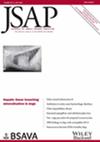To report the incidence of feline hypoalbuminaemia and characterise the distribution of presenting disease categories and pathoaetiologies of hypoalbuminaemia in cats. The secondary aim was to evaluate the relationship between hypoalbuminaemia and clinical outcomes.
Medical records of cats with hypoalbuminaemia (<28.0 g/L, reference interval: 28.0 to 39.0 g/L) presenting to a veterinary teaching hospital over 5 years were retrospectively reviewed. The severity of hypoalbuminaemia was further stratified into mild (24.0 to 27.9 g/L), moderate (20.0 to 23.9 g/L) and severe (≤19.9 g/L) groups. The median albumin and severity groups were compared between the determined disease categories, pathoaetiologies and clinical outcomes.
The incidence of hypoalbuminaemia was 32.7% (533/1632). Gastrointestinal disease was the most common disease category associated with hypoalbuminaemia [154/533 (28.9%)], of which, 49.4% (76/154) of cats had gastrointestinal neoplasia. Neoplastic [159/533 (29.8%)] and inflammatory conditions [158/533 (29.6%)] were common pathoaetiologies noted. Statistically significant differences in the serum albumin between individual disease and pathoaetiological categories were found. Cats with moderate to severe hypoalbuminaemia had a statistically significantly longer hospitalisation period, cost of treatment and increased odds of death (odds ratio 2.4, 95% confidence interval: 1.3 to 4.6 and odds ratio 3.2, 95% confidence interval: 1.5 to 6.6, respectively).
The incidence of feline hypoalbuminaemia in our study surpasses previous canine reports. Our findings support albumin as a negative acute phase protein in cats, with hypoalbuminaemia frequently associated with inflammatory disease. Hypoalbuminaemia also features prominently in cats with gastrointestinal neoplasia, indicating careful appraisal of the presence of protein-losing enteropathy is required in these cases. Finally, albumin is found to be a prognostic indicator in this study.



